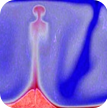 |
Most of planetary body interiors are inaccessible, even Earth. However, the conditions at depth can be simulated in high pressure devices in the laboratory, such as the diamond anvil cell used in Dan Shim's lab and multi-anvil press in Kurt Leinenweber’s lab. What are planets made of? What are the properties of planetary materials? These are the key questions we try to answer through laboratory experiments. Why is it important to understand the properties of planetary materials at a wide range of pressures and temperatures? The properties of planetary materials allow us to understand a wide range of planetary processes, such as magnetism, volcanism, tectonics, differentiation, core formation, atmosphere formation, water (or volatile) cycle, etc. Kurt Leinenweber, Tom Sharp, and Dan Shim, in a multi-disciplinary fashion with other SESE geophysicists and scientists, measures the properties of planetary materials at a wide range of pressures and temperatures and apply the results to understand the structure and evolution of planets.
MORE INFO (Dan Shim)
|





